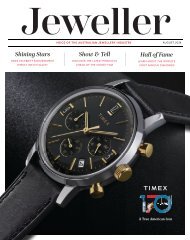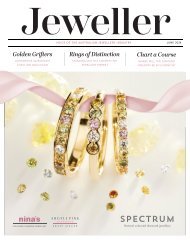Jeweller - July, Edition I 2020
» Talking stock: Simple strategies to maximise profits on your product » Fine resilience: First instalment of the 2020 State of the Industry Report » History lesson: Evolution of jewellery chain stores over the past decade
» Talking stock: Simple strategies to maximise profits on your product
» Fine resilience: First instalment of the 2020 State of the Industry Report
» History lesson: Evolution of jewellery chain stores over the past decade
Create successful ePaper yourself
Turn your PDF publications into a flip-book with our unique Google optimized e-Paper software.
Chains through the decade | STATE OF THE INDUSTRY<br />
<strong>2020</strong><br />
STORE COUNT<br />
Top 5<br />
Resilient<br />
Chains<br />
continual increase in shopping centre<br />
tenancy costs – particularly persquare-metre<br />
rents – has resulted in an<br />
unsustainable business model, especially<br />
when ‘rent’ includes a percentage of sales.<br />
This structure further reduces the margin<br />
on already low-margin items.<br />
The collapse of 343 fashion<br />
jewellery stores, along with<br />
Colette’s 99 stores currently being<br />
in the hands of administrators,<br />
leads to the question: why has<br />
the retail landscape changed so<br />
drastically over the past decade<br />
for the lower end of the market?<br />
Fine jewellery chains’ resilience<br />
If one considers the long list of apparel and<br />
accessories chains that have collapsed<br />
over the past five years – including Roger<br />
David, Marcs, Ed Harry, Rhodes & Beckett,<br />
Bardot, and Jeanswest, among others – as<br />
well as international chains which have<br />
withdrawn from the Australian market, such<br />
as Topshop, Esprit, Jigsaw, and Karen Millen,<br />
fine chains have been surprisingly resilient.<br />
Michael Hill Australia has expanded<br />
throughout the past decade, with 12 more<br />
stores in <strong>2020</strong> (156) than it had in 2010 (144).<br />
However, those figures belie the fact that the<br />
company went through major upheaval when<br />
it exited the US market in 2018, closing nine<br />
stores.<br />
5 additional stores<br />
since 2010<br />
5 additional stores<br />
since 2010<br />
No store closures<br />
since 2010<br />
Only one fewer<br />
store since 2010<br />
Only one fewer<br />
store since 2010<br />
At that time, the Australian store count<br />
had reached 172, which means that since<br />
2010, when its store count was 144, it<br />
opened as many as 28 stores to February<br />
2018 – yet in the ensuing period it has<br />
closed 16 stores (see chart page 40).<br />
Michael Hill experienced a number of<br />
other ups and downs. The ASX-listed<br />
company decided to expand its ‘brand’<br />
offering by establishing a new retail chain<br />
in 2014 called Emma & Roe – named<br />
after founder Sir Michael Hill’s daughter<br />
Emma and his wife’s maiden name, Roe.<br />
The new stores attempted to specialise<br />
in ‘demi-fine’ charms, bracelets,<br />
necklaces, earrings and stackable rings.<br />
The concept was trialled for 18 months,<br />
beginning in five Queensland stores<br />
in 2013 under the Captured Moments<br />
brand. After receiving “encouraging<br />
results”, the company opened its first<br />
Emma & Roe concept store in Mackay,<br />
Queensland, in April 2014.<br />
Even though the number of Emma &<br />
Roe stores quickly increased, the venture<br />
ultimately proved unsuccessful. By June<br />
2018 then-CEO Phil Taylor announced<br />
the closure of all 36 stores.<br />
The ‘big boy’ of the Australian jewellery<br />
industry, James Pascoe Ltd (JPL), the<br />
owner of Prouds, Goldmark and Angus<br />
& Coote, remains the largest group, as<br />
it was in 2010. Since then it has had a<br />
net loss of only 10 stores, or 2 per cent,<br />
declining from 469 to 459.<br />
While the result is impressive, like<br />
Michael Hill, the company has<br />
rationalised its store mix and footprint<br />
TABLE 3: FINE & FASHION JEWELLERY<br />
CHAINS’ STORE COUNT <strong>2020</strong><br />
Chain<br />
Stores<br />
Prouds 261<br />
Michael Hill 156<br />
Lovisa 140<br />
Pandora # 125<br />
Angus & Coote 122<br />
Colette* 99<br />
Goldmark 76<br />
Wallace Bishop 38<br />
Zamels 37<br />
Shiels 36<br />
Mazzucchelli's 30<br />
Bevilles 24<br />
Salera’s 20<br />
Hoskings 16<br />
Gregory 15<br />
Silver Shop 7<br />
Graham's 6<br />
Regency 6<br />
Anthonys 5<br />
Hardy Brothers 5<br />
TOTAL 1224<br />
# Pandora was not included on the Chain Store list in<br />
2010 as it was defined as a ‘brand-only’ store while<br />
* Colette did not exist as a chain in 2010 however, it<br />
is now under administration<br />
Prouds<br />
Angus & Coote<br />
CHART 2: PROUDS, ANGUS & COOTE AND GOLDMARK STORE GROWTH SINCE 2003<br />
Goldmark<br />
PROUDS STORES<br />
Stores<br />
300<br />
200<br />
100<br />
0<br />
2003 2007 2010 <strong>2020</strong><br />
ANGUS & COOTE STORES<br />
Stores<br />
150<br />
100<br />
50<br />
0<br />
2003 2007 2010 <strong>2020</strong><br />
Stores<br />
150<br />
100<br />
50<br />
0<br />
2003 2007 2010 <strong>2020</strong><br />
The above charts show the growth of the three James Pascoe Ltd (JPL) chains stores. It should be noted that Angus & Coote and Goldmark were not part of JPL in 2003, which acquired the<br />
ASX-listed Angus & Coote in a reverse takeover deal for $76 million in 2007.<br />
GOLDMARK STORES<br />
<strong>July</strong> <strong>2020</strong> | 35


















